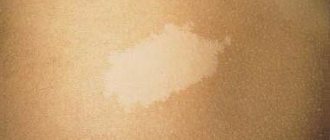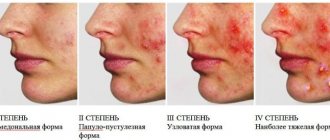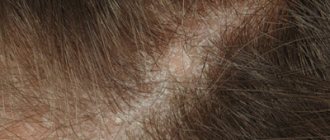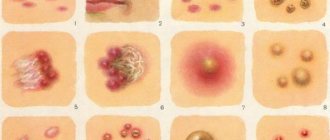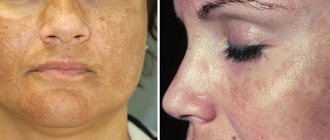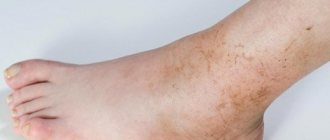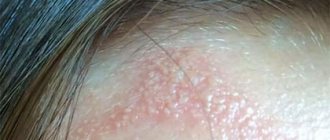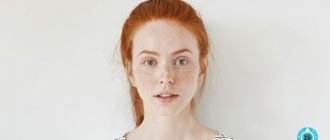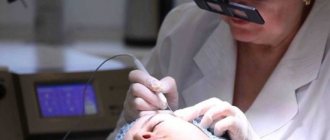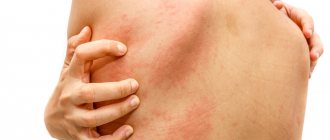Dependence of symptoms on localization
Typically, symptoms depend more on the cause than on the area where they are localized. Thus, a red, itchy rash can appear on the forehead, cheeks, and chin.
Photo: With allergies, the face often swells and red rashes appear
- However, for example, in the eye area, most often it is not a rash that develops, but swelling, redness, lacrimation and conjunctivitis.
- Lips , like the eyes, most often swell, there is a feeling of tingling and swelling from the inside, they turn red, as if filled with blood, blisters may appear, especially on the mucous membrane on the inside.
- An allergy to the ears is manifested either by their generalized (extensive) redness and itching, in which case it is most likely a food allergy, or by local inflammation, peeling and dryness, in which case the allergy is more likely a contact one (for example, to jewelry or to the material of a headdress) .
Can there be an allergy only on the face? Absolutely yes. This option is possible for contact allergies, local administration of medications and cosmetics, allergies to the sun (if, for example, only the face is exposed), household allergies (for example, animal hair getting into the eyes or the mucous membrane of the lips).
Traditional recipes for allergic rashes
What should you do if rashes appear on your face, your skin itches and burns a lot? In addition to traditional therapy, you can use folk remedies. To relieve redness and irritation, it is useful to wipe the skin with ice cubes from a frozen peppermint decoction. This procedure soothes the irritated dermis and stimulates blood flow from areas of erythema.
At home, you can wash your face with decoctions of chamomile, string, valerian root, celandine, and calendula flowers. Herbs are brewed at the rate of 2 tablespoons per 0.4 liter. boiling water, leave for 2 hours. Then soak a cotton pad in the prepared medicine and gently wipe your face.
If there is no severe inflammation and suppuration of the blisters, ointment with sea buckthorn oil will help get rid of the rash. Take 50 g of softened pork lard, add 10 drops of oil and a little aloe vera juice. The ingredients are mixed and placed in the refrigerator. You need to lubricate your face 2-3 times a day until the wounds are completely healed and the crusts come off.
Allergic rashes on the face can appear after exposure to external or internal irritants. To carry out effective treatment, it is necessary to identify and eliminate the allergen. Antihistamines, ointments for external use and folk remedies help relieve unpleasant symptoms.
Treatment of allergies in adults on the face
When a person, especially if she is a woman, has an allergy on her face, “what should I do?” - this is the first question that arises, bordering on panic, and rarely does anyone not pay any attention to this problem. First of all, it must be said that self-medication is dangerous.
- As already mentioned, it may not be an allergy, but an intolerance to a particular substance, and then anti-allergenic drugs will not only not help, but can also cause harm;
- The variety of drugs is very high, and only a doctor can confidently choose the right one;
- A self-diagnosis error will lead to “untreated” disease that has caused allergy-like symptoms, which can significantly aggravate the condition and worsen the prognosis (for example, in the case of systemic lupus erythematosus).
However, if the allergen is clearly identified and the symptoms leave no doubt, treatment can begin while waiting for a doctor’s consultation.
First of all, it is necessary to completely eliminate contact with the allergen, and then take all other measures. So, how to treat facial allergies?
Drug therapy
Treatment of facial allergies, like any other pathology, is divided into etiopathogenetic (impact on the cause and process of development of the disease) and symptomatic (treatment of the manifestations themselves).
Photo: Purulent allergic rashes
The Association of Allergists and Clinical Immunologists has developed recommendations for the treatment of all types of allergic diseases, including:
- immunotherapy,
- extracorporeal (outside the body) methods of purifying blood from allergen,
- antihistamines,
- medications that alleviate the condition.
The last two points are available to ordinary people.
Detailed information about ointments and other remedies for facial allergies is contained in this article:
In case of food allergies , first of all, gastrointestinal symptoms, if any, are treated with the help of sorbents, for example, Enterosgel, Smecta, Polysorb. Often, with their elimination, skin manifestations also go away.
For local therapy, hormonal ointments for facial allergies and non-hormonal drugs are used.
Hormone-based ointments can be used only if there is confidence in the absence of infection and strictly as prescribed by the doctor. Some of the most popular and effective drugs are Sinaflan and Advantan.
- Sinaflan ointment is applied to skin treated with an antiseptic solution 2-4 times a day. The course of treatment lasts from 10 to 25 days and can only be adjusted by a doctor.
- "Advantan" is rubbed into the affected areas of the skin once a day, the course of treatment can last up to 12 weeks.
Non-hormonal ointments, creams and gels can be antihistamine, antipruritic, anti-inflammatory, healing (detailed information about ointments for facial allergies can be found here).
Solcoseryl ointment for facial allergies has a powerful regenerating, wound-healing effect, and is often used in the treatment of infected, non-healing wounds with significant peeling, dryness and irritation of the skin.
"Fenistil Gel" has an antihistamine, antipruritic effect, applied 2-4 times a day to the affected areas of the skin. Combines well with oral (for oral administration) medications. Although with caution, it can be used by women who have facial allergies during pregnancy, as well as by children older than 1 month.
Among restorative preparations, La-Cri is becoming very popular, designed to deeply moisturize damaged, dry, flaky skin. It is not a medicine and can be used without a doctor's prescription.
In addition to local therapy, it is possible to use tablet forms of antihistamines , for example:
- "Claritin"
- "Suprastin"
- "Tavegil".
You must read the instructions carefully!
Remember: Many allergy medications make you drowsy, and after taking them you should not drive or do work that requires alertness.
Therapy with folk remedies
There are known effective remedies for facial allergies, the safety of which is confirmed not only by reviews of Internet users, but is also recognized by evidence-based medicine.
Before moving on to the description of recipes, it is necessary to note that folk remedies, along with pharmaceutical ones, can cause a new, secondary allergy, in addition, they have no less (and sometimes even more) number of contraindications and side effects.
Therefore, before using them, you should carefully study the information about them and also consult your doctor.
The prevailing opinion that doctors do not prescribe folk remedies is wrong: if a specialist is confident in a method, and this method is appropriate in a given case, he will definitely recommend it.
Boric acid
- 1 tbsp. water;
- 1 tsp. drug.
A well-known folk remedy for facial allergies. It will help relieve inflammation and eliminate itching. It is recommended to dilute a teaspoon of this substance in a glass of water and treat your face with this solution for 1.5-2 weeks.
Celandine
Celandine, having an anesthetic (pain-relieving), wound-healing and bactericidal effect, can help cope with itching, peeling and irritation of the skin.
Components:
- 2 tbsp. dry crushed celandine,
- 2 tbsp. boiling water
Pour boiling water over the herb, leave in a warm place for 4 hours, strain, and cool. Treat affected skin areas twice a day.
It is possible to use celandine internally, but in this case it is better to use ready-made filter bags rather than collect it yourself, because the juice of this plant contains poisonous alkaloids, and if prepared incorrectly, you can be poisoned by it.
Chamomile, sage, string and laurel help well. You should refrain from using vinegar in the treatment of allergies, because... This remedy has many contraindications and side effects.
Treatment methods for allergic acne on the face and body
Drug therapy
antihistamines
- Tavegil
- Fenistil
- Zodak
- Suprastin
- Cetirizine
- Diazolin
- Claritin
hormonal ointments Non-hormonal ointments with antibiotics
Levomekol
sorbents
Preparations such as Polysorb and Enterosgel can be added to homemade acne masks. They will help get rid of rashes. Taking these sorbents internally will help cleanse the body of toxins.
antibacterial therapy
rhinitis
Folk remedies
- Applications based on black or green tea. You need to dip a cotton pad in lightly brewed tea and apply it to the areas with the rash for 15 minutes. The procedure can be repeated up to 3 times a day.
- Nettle infusion. Take 10 g of fresh or dried leaves of the plant, pour 250 ml of boiling water. Let the infusion stand for 2 hours, then strain. Take the medicine orally every day, half a glass. Nettle is also used to combat acne of any origin - read about it here.
- Lotions using a decoction of medicinal herbs. You need to take a tablespoon of oregano, string and calendula in dry form. Pour a liter of boiling water over the raw materials and cook for 15 minutes. Then strain the broth and cool. Soak gauze folded in several layers in it and apply to problem areas for 10-15 minutes. Repeat the manipulation twice a day.
- Decoction of bay leaf. Take 5-6 leaves, pour a glass of boiling water over them, and put the container on the fire. Boil for 20 minutes. With the cooled and strained broth, you can wipe areas with rashes or make compresses.
- Calendula infusion. You need to take 10 g of flowers and 100 ml of boiling water and mix. Let it brew for 3 hours. Take the product orally, a tablespoon, three times a day.
- Decoction of celandine. You need to take 2 tablespoons of crushed dry celandine, pour 2 cups of boiling water. Infuse the liquid for 2 hours, then strain and cool. Treat affected skin areas twice a day. Find more recipes for acne with celandine here.
- To eliminate itching and remove redness, you can lubricate the skin with sour milk or kefir.
- It is recommended to take a mummy solution (1 g of substance per liter of warm boiled water) orally, 100 ml per day. You can also make face masks based on mumiyo, which are described here.
- To soothe the skin after compresses and lotions, you can apply hypoallergenic talc or dry potato starch to it.
You can find more traditional medicine recipes against acne here: https://domadoktor.ru/763-narodnye-sredstva-ot-pryshchej.html. But you need to be careful, as herbs can also cause an allergic reaction.
How to mask an allergy - answers to frequently asked questions
Is it possible to “cover up” an allergic rash with foundation? If this is an urgent need, for example, to go to an important meeting that will last no more than a couple of hours, then you can. However, you need to understand that such an action will not only not help in treating the disease, but will easily aggravate the situation.
If substances contained in cosmetic products come into contact with irritated skin, they can cause a new allergy. In addition, damaged skin will not receive enough oxygen, which is so necessary for regeneration.
If the cosmetics are not of very high quality, then they will not only not moisturize the skin of the face, but will also dry it out even more. Due to these factors, masking allergies is not recommended.
A logical question immediately arises: how long does an allergy on the face last?
There is no exact answer. The time for symptoms to disappear can vary from a couple of days to several weeks, it depends on how well the person is isolated from the allergen, whether he takes treatment measures or let everything take its course, and, of course, on the individual characteristics of the body.
Moisturizing creams will help speed up the skin healing process, as well as lifestyle changes: a hypoallergenic lifestyle and diet.
There is another problem: what to do if there are spots on your face after an allergy?
Most often, residual effects occur after photodermatitis. In this case, it is recommended to take antioxidants (for example, vitamin C), as well as the use of special emulsions based on melatonin.
Such preparations include the restoring cream-emulsion “Sweet Skin System Melajeune Fluid”. This cosmetic product helps restore the natural course of physiological processes in all layers of the skin, normalizes water metabolism, helps improve the structure of the skin, thereby eliminating persistent pigmentation.
How to restore facial skin after allergies?
Actively use restorative, regenerating, moisturizing creams. In addition, you should contact a dermatologist or cosmetologist who will help you choose the medications that are suitable for each specific case.
It is important to adhere to a hypoallergenic diet, avoid increased insolation and exposure to other natural factors on the skin (strong wind, frost).
Causes
Allergic rashes on the face can appear when exposed to an allergen, namely:
- food;
- medicines;
- cosmetics;
- plant pollen;
- dust;
- pet hair;
- insect bite;
- frost or sun.
Facial skin allergies can be a consequence of impaired metabolism. The allergen enters the body through the blood, skin or mucous membranes, with air, food or water.
Allergy is an incorrect reaction of the immune system to internal and external irritants, so manifestations can appear under the influence of such unfavorable factors:
- hereditary predisposition;
- decrease in the body's defenses;
- avitaminosis;
- stress;
- changing of the climate;
- drinking alcohol and smoking.
Allergy prevention
Preventive measures include:
- hypoallergenic diet;
- hypoallergenic living (no pets, daily wet cleaning);
- minimizing the number of stressful situations: the risk of an allergy on the face due to nervousness increases;
- careful selection of cosmetics, constant use of the same brand of cosmetics;
- refusal to use large amounts of cosmetics;
- refusal to use waterproof mascara, cosmetics and perfumes in unnaturally bright colors;
- refusal to wear jewelry/decorations made of precious metals (depending on the type of allergy);
- use of carefully selected sunscreens;
- consultation with an allergist-immunologist in case of any questions.
Facial allergies in children
Allergic diseases are more common in children than in adults. This is due to the still fragile immune system and a large number of new allergens unfamiliar to the child’s body.
Allergies in children under three years of age
Facial allergies in infants are a very common phenomenon. Most often, this is how food allergies manifest themselves (to cow's milk or complementary foods), or contact allergies (to cosmetics). You can read more about how allergies manifest on the face in newborns here.
Photo: Severe food allergies (milk, eggs) on the face of a baby
Facial allergies in a child between one and three years of age are most often associated with his transition to a general diet. Every month the baby tries new and new foods, begins to realize what is tasty and what is not so good, and that it is possible to refuse one food and get another.
Eating tasty but allergenic food in large quantities (fruits, fruit purees and juices, chicken eggs, cow's milk) leads to the development of allergies, even if there were none initially.
So, Dr. E.O. Komarovsky writes a lot about childhood allergies. In particular, he believes that for the most part it is associated not so much with the hypersensitivity of the immune system, but with overfeeding the child.
Food allergies in young children most often manifest themselves on the face as a finely blistered red-pink rash, often weeping and itchy.
Contact allergies in children most often develop to hygiene products and children's cosmetics, including oils and creams. A separate point is an allergy to washing powder.
Some difficulties arise from the need to distinguish other diseases from allergies. But the question of how to distinguish prickly heat on the face from an allergy is quite simple: prickly heat appears in areas of poor skin hygiene, for example, in the folds of the neck, buttocks, and groin. Heat rash does not occur on exposed areas of the skin, such as the cheeks or forehead.
Allergies in children over three years of age
At this age, children most actively explore the world around them. They “get to know” pets, dusty corners, and understand that they can steal delicious chocolate candy from the table. Allergies to hygiene products occur much less frequently than in infants.
At this age, allergies often appear on the elbows, forearms, and cheeks.
Its symptoms are no different from adults:
- itching;
- sometimes burning;
- peeling of the skin;
- dryness;
- redness;
- appearance of a rash.
Treatment of the disease
Allergies affect the facial skin: itchy rashes and atopic dermatitis (crusts, dry skin, peeling, cracks) are observed. The patient's condition changes: sleep deteriorates, irritability and migraine appear.
In search of an answer to the question: how can an allergy on the face of an adult be cured, people seek medical help. Most often, doctors recommend identifying the allergen and eliminating contact of a sick person with it.
Laboratory diagnostics help to identify substances that cause hypersensitivity. To relieve symptoms, first and second generation antihistamines are prescribed (Zyrtec, Zodak, Suprastin and others).
The doctor may recommend hormonal ointments for local use; in severe cases, glucocorticosteroids are taken orally. Mothers of infants often ask: what to do if a child has an allergy on his face.
Treatment of facial allergies in children
The most detailed information about the treatment of allergies in infants is contained in this article. For children, as for adults, there are pharmaceutical and traditional methods of treatment.
Hormonal ointments are used in children, but also strictly as prescribed by a doctor. "Advantan" and "Elocom" are the most effective representatives of glucocorticosteroid ointments. Effective for dermatitis in the absence of infection.
Non-hormonal ointments, similar to adults, can be antihistamine, antipruritic, moisturizing (including emollients) and universal.
"Bepanten" for facial allergies can be used in children from birth and is a good regenerating ointment. Able to cope with itching due to the action of the active substance, relieve inflammation. For external use only, apply a thin layer 1-2 times a day.
Facial allergy cream "Sudocrem" combines anti-inflammatory, antibacterial, wound-healing and moisturizing effects, and among the contraindications is only hypersensitivity to one or another of its components. Can be used at any age.
Causes of allergic reactions on the face
The causes of facial allergies are not always obvious and are identified quickly. Sometimes it takes months to find the factor that triggers the rash. The most common causes of facial allergies are:
- medications (this form of the disease is called drug allergy);
- food products;
- preservatives;
- molds;
- ultraviolet (sun);
- some components of cosmetics;
- different types of plants (especially their pollen);
- insect bites;
- dust (this is a reaction to mites that live in this dust);
- Pets.
Allergic reactions on the face may appear within 2–3 days after direct contact with the allergen. Even with the most minor allergic rashes, it is recommended to pay special attention to the skin, because over time, such a reaction of the body can become a real pathology, causing irreparable, very significant harm to various organs and systems.
At the same time, the mucous membrane, lymphatic system, and respiratory organs (lungs, bronchi) are affected at an accelerated pace.
All this can lead to serious health problems. Therefore, it is recommended to solve this problem as soon as possible. First you need to distinguish allergic rashes from other skin phenomena on the face.

